They were recruited in POW camps, which after the German aggression against the USSR were filled with Soviet soldiers. Some of them went to the enemy side with a weapon in their hand. Soviet volunteers became an important element of the Nazi war machine. How many fought for the side of the Germans and why so many?
When Germany attacked the Soviet Union in the summer of 1941, the Wehrmacht command assumed (and in an optimistic scenario) the taking of tens of thousands of prisoners. The reality, however, exceeded the wildest expectations of the Nazi generals.
By the turn of 1941 and 1942, 3.2 million Soviet soldiers had been captured by the Germans. Over 2 million of them, unfortunately, died as a result of the terrible living conditions in the camps. At least initially, the German authorities were not fully aware of the valuable resources they had at their disposal.
Hilfswillige
The first Soviet POWs found themselves in auxiliary formations of the German army in the fall of 1941. From the term Hilfswillige or literally "eager to help" they were called . hiwis They served as orderlies, drivers, guards, storekeepers or ordinary blue-collar workers. One of them is mentioned by the German artilleryman Gottlob Herbert Bidermann in his memoirs entitled "In deathly battle":
In our company we had Alex, a former Soviet soldier from the Caucasus, who was taken prisoner by one of our units during the fight. He was never sent to a POW camp, but was employed to look after the horses and help in the kitchen. Until the last days of the war, he remained a faithful and steadfast assistant to our procurement services.
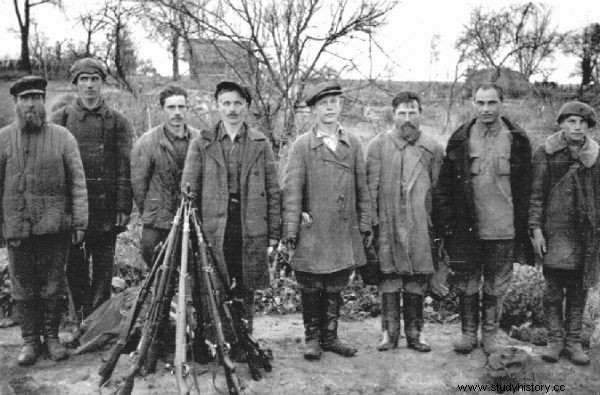
The photo shows Russian volunteers who supported the German army in the fight against partisans.
The first self-defense units, the so-called Schumas, also appeared in the Baltic states. Then they were turned into notorious regular police forces. The Lithuanians alone formed 35 battalions, totaling about 20,000 people. In total, in the spring of 1942, about 200,000 former Soviet citizens served in the German ranks at the back of the front. By the end of this year, their number had risen, according to some estimates, even to a million!
Osttruppen
However, Soviet prisoners of war were used not only to perform auxiliary and order functions. Bidermann mentions other tasks in which they proved invaluable:
Many ex-prisoners of war volunteered to fight backline guerrillas, and these men proved successful in securing sensitive communication and transport routes .
Units called Osttruppen were formed from volunteers. Their soldiers received German uniforms and equipment. There were Russians among them, but most of them were recruited from nations conquered either during the times of tsarist Russia or already during the existence of the USSR. These were, among others, Estonians, Latvians, Kalmyks, Turkmen and Cossacks, as well as Belarusians and Ukrainians. In May 1943 there were 10 regiments, 170 battalions, 221 companies and 11 independent Osttruppen platoons.

The article was inspired by Gottlob Herbert Bidermann's book In the Deadly Battle. Diaries of a German soldier from the Eastern Front. Buy with a discount on bonito.pl.
Some German commanders saw great potential in creating this type of unit. Field Marshal Fedor von Bock even proposed the creation of an anti-Soviet Russian army fighting alongside the Wehrmacht. His memorandum, however, was refused by the head of the Wehrmacht High Command (OKW). Field Marshal Wilhelm Keitel did not dare to present this idea to Hitler. This old belayer had no imagination to believe that this extraordinary project could hold the key to victory in the east.
RONA and the Russian SS
From the end of 1941, the Russian People's Liberation Army (RONA) was active alongside the Germans. It was created as a militia formation of the so-called Łokocki Republic, located in the Bryansk region on the border with Ukraine. The unit was developed under the command of Bronisław Kamiński, a Russian of Polish-German origin, a former soldier of the Red Army, a sadist, moczymorda and a womanizer.
RONA took part in numerous anti-insurgency actions in the east and in suppressing the uprising in Warsaw, where she committed numerous crimes. Kamiński himself died in unexplained circumstances in October 1944. The Germans planned to transform the brigade into the 29th Waffen SS Grenadier Division. Eventually, it was formed by the SS "RONA" Assault Brigade.
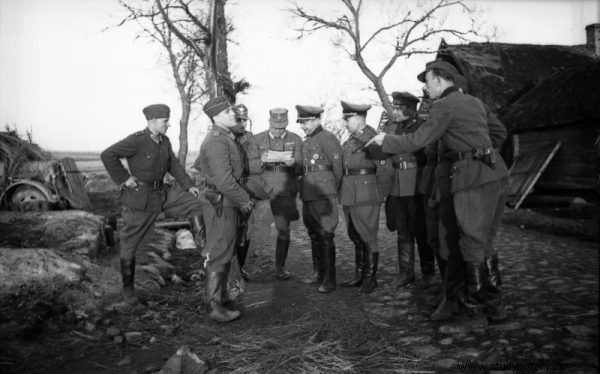
In the photo, Bronisław Kamiński talks with German policemen and members of RONA during an anti-partisan action in Belarus in 1944.
It was not the only purely Russian unit within the SS structures. In April 1942, the Combat Union of the Russian People was established in Suwałki. Its commander was appointed the former chief of staff of the Soviet 229th Rifle Division, Lieutenant Colonel Vladimir Gil, who took the pseudonym "Rodionov". Another formation was established at the end of 1942. It was commanded by a former NKVD and artillery officer, Captain Andrei Błażewicz. Soon both divisions were merged and thus 1 was established. Russian National SS Brigade .
The brigade became famous for its bloody pacifications in Belarusian villages. However, her life was not long. Already in mid-August 1943, under the influence of German failures at the front, the soldiers commanded by Gil-Rodionov switched to the Soviet side. Before joining their new superiors, they murdered their German instructors and over a dozen Russian comrades, including Captain Błażewicz.
Then the former Russian SS men formed the 1st Anti-Fascist Partisan Brigade. Her career was just as short-lived. After several considerable successes in the fight against the German occupiers, the formation was smashed by the Germans in mid-May 1944, and Gil-Rodionow was killed.
Cossacks
It seems that the Cossacks were the most numerous group of former Soviet citizens who fought against the Stalinist regime alongside the Germans. It is hardly surprising. They had personal settlements with the Soviet state. In the interwar period, they were persecuted by the Bolsheviks, so they welcomed the entering Germans as liberators. Almost all Cossack units then went over to the German side . One of the first was a formation led by a Red Army major, Ivan Kononov, who deserted in the third decade of August 1941.
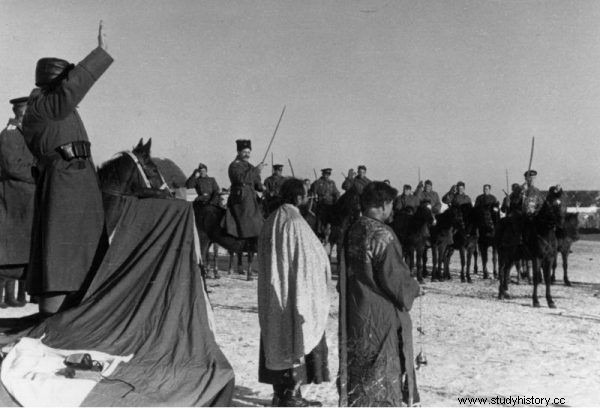
Soldiers of the 1st Cossack Cavalry Division in a photo taken by the Germans as part of a propaganda campaign.
Gradually, new units were created, consisting of the Cossacks allied with Germany. In the summer of 1943, the 1st Cossack Cavalry Division was established in Mława under the command of Helmuth von Pannwitz. In November 1944, the 2nd Cossack Cavalry Division was created. These two units were then formed into the XV SS Cossack Cavalry Corps. It numbered about 50,000 soldiers.
Altogether, up to 250,000 Cossacks served in various formations in the ranks of the German army . They were used mainly in the fight against the Soviet partisans. The Pannwitz division was transferred to Yugoslavia, where it participated in the battles with Josip Broz Tito's troops.
The fate of about 25,000 Cossacks from the 1st Cavalry Division was not very fortunate. They capitulated in the vicinity of Klagenfurt to the British. They deported them into the hands of the Soviets. Many Cossack cavalrymen committed suicide during the transport. They were aware of what awaited them in Stalin's state and preferred death to Soviet labor camps.
Vlasov
In mid-July 1942, General Andrei Vlasov was taken prisoner by the Germans. He was one of the most talented Soviet commanders, decorated with the Order of Lenin for the defense of Moscow. Meanwhile, in the camp for Soviet prisoners of war he proved to be ... a bitter opponent of Stalin and communism. Finally, succumbing to persuasion from the Germans, he decided to fight against the USSR by their side.
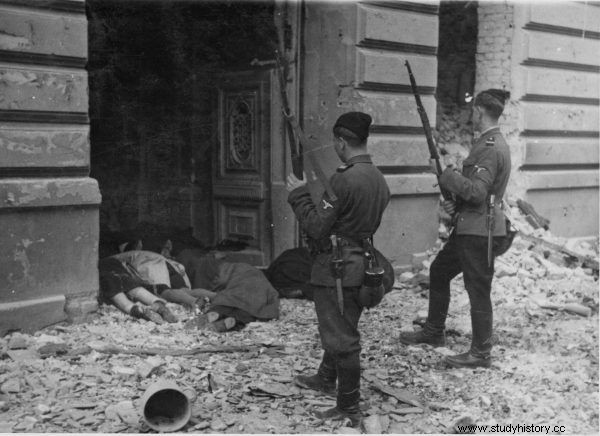
Soviet prisoners of war who crossed over to the side of the Third Reich participated in the pacification of the Warsaw ghetto in 1943. In the photo, soldiers of a collaborative SS unit look at the bodies of murdered Jews.
While still in the camp, Vlasov edited a propaganda leaflet for the Red Army, blaming Stalin for all the failures so far and calling for his overthrow. The effect was electrifying. At the front thousands of Soviet soldiers abandoned their weapons and went over to the German side to fight under the command of a general. In December 1942, the Russian National Committee headed by Vlasov was established in Smolensk. It seemed that Germany, thanks to cooperation with him, has a trump card up its sleeve.
However, in the top leadership of the Reich, resistance to the creation of a separate Russian army under German auspices persisted. Hitler himself in June 1943 declared that "organizing a Russian liberation army is a dangerous fantasy", and he himself "will never agree to form it". Meanwhile this summer, between 800,000 and a million former Soviet citizens served on the Eastern Front.
Their importance was appreciated in the fall of 1943, when Hitler, as a result of failures at the front, ordered all eastern units to be disbanded in a fit of rage. He wanted to send their members to mines in France, but it turned out that there was no one to replace these people with. Their return threatened to collapse the entire eastern front!
Ultimately, the formation of the 1st Division of the Russian Liberation Army (ROA) took place only in November 1944. A new Committee for the Liberation of the Russian People was also established. All thanks to an unexpected ally, which turned out to be the Reichsführer-SS himself, Heinrich Himmler. It was planned to create five divisions made up of Soviet prisoners of war. In the end, only two were created. The Wehrmacht and the SS did not want to give up their tried and tested troops, and German industrialists were reluctant to get rid of their free workforce ... And it was already late. At this stage, the war was basically lost.
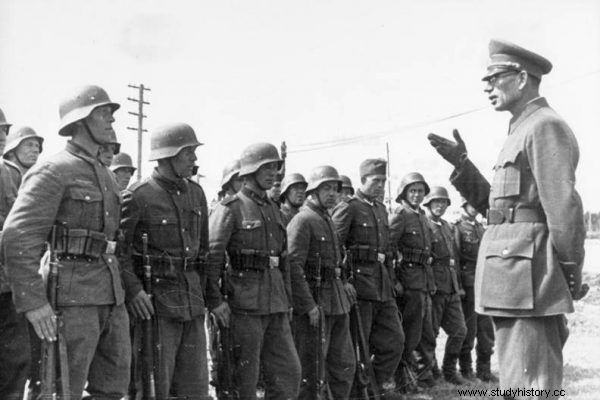
General Andrei Vlasov speaking to ROA soldiers in 1944.
How many were there
The mass exodus of Red Army soldiers to German troops is a phenomenon virtually unheard of in the history of wars. Its scale is shocking. According to data from October 1944, 800,000 volunteers from the east served in the Wehrmacht and the SS. A further 100,000 fought in the ranks of the Luftwaffe and the Kriegsmarine.
Many of those who decided to cooperate with the Germans were taken prisoner by the Soviets during the fighting. For those who surrendered to American or British troops, an unpleasant surprise awaited them:they were deported to the USSR. In addition to the above-mentioned Cossack cavalrymen, this also happened with about 17,000 Vlasov's soldiers, who were later either executed or ended their lives in the Gulag camps. Only a few managed to get through to the West.
Vlasov himself, betrayed by one of his subordinates, was tricked into an American convoy by Soviet fighters. On August 2, 1946, the Soviet daily Izvestia stated in a short note that the general and 11 of his associates were sentenced to death for treason and hanged. The Soviet journalist did not just say that former members of the Russian Liberation Army were hung from butcher's hooks stuck in the back of the head.
Buy with a discount on bonito.pl

